Question: Foreign Infants Adoption Inc. (FIA) is a
Foreign Infants Adoption Inc. (FIA) is a consulting company wholly owned by Roger Tremblay, a wealthy, recently retired lawyer. FIA helps Canadian families adopt infants from other countries. Typically, these infants have been abandoned or have lost their parents to disease or war, and are being sheltered in government-sponsored orphanages. Further information on the activities of FIA can be found in Exhibit VI. FIA is a full-service coordinator, helping parents with all aspects of the international adoption process (Exhibit VII). The company charges a fee to cover the costs associated with the adoption process and its consulting service.
FIA is required to be registered as an international adoption coordinator with the Canadian government, and as such must follow certain criteria set out by Citizenship and Immigration Canada (CIC).
Effective July 1, Year 7, CIC now requires all registered coordinators to submit audited financial statements in accordance with IFRS, and to hold fees collected in trust on behalf of the parents. The fees requirement also applies to all adoptions already in process. Throughout the adoption process, FIA can only withdraw funds from the trust to pay for adoption-related expenses. Once an adoption has been finalized, FIA can withdraw the remaining funds.
FIA's financial statements have never been audited or reviewed. The company relies on the services of a full-time bookkeeper to complete its internal financial statements. The financial statements for the most recently completed year are presented in Exhibit VIII, and additional information is presented in Exhibit IX.
It is August 15, Year 8, and you are a CPA with the firm of Mitton Horne McKnight Chartered Professional Accountants (MHM). The partner on the engagement, Kate Horne, has asked you to address the accounting issues for the FIA engagement.
Exhibit VI:
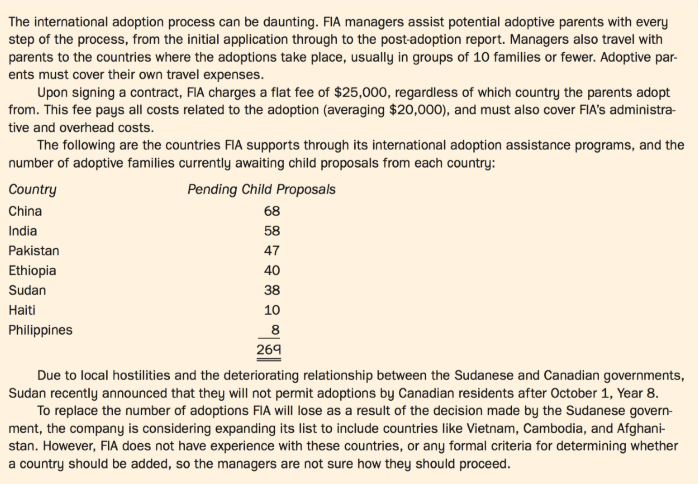
Exhibit VII:

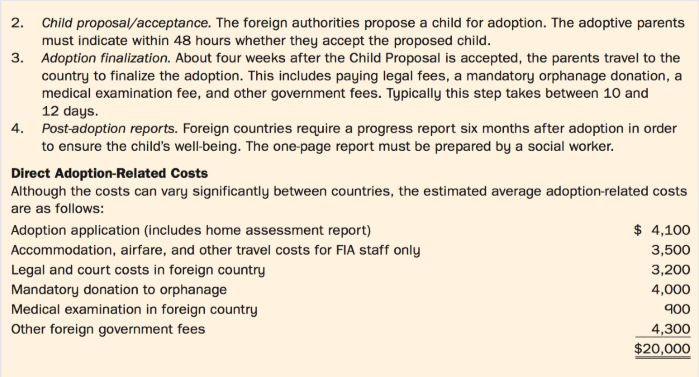
Exhibit VIII:
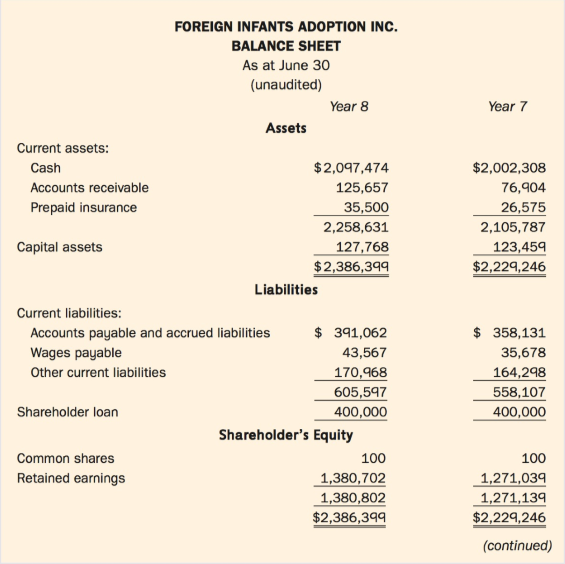
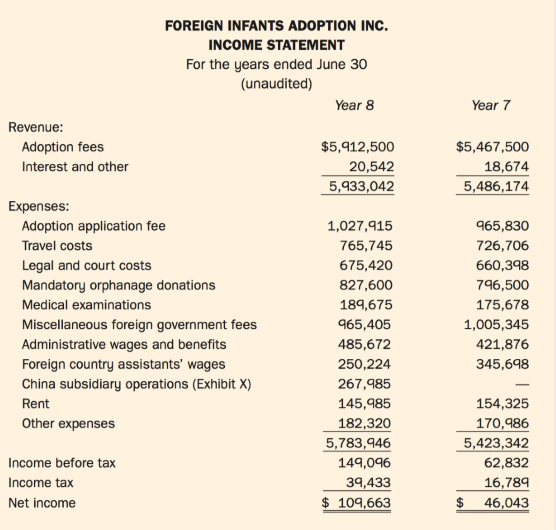
Exhibit IX:
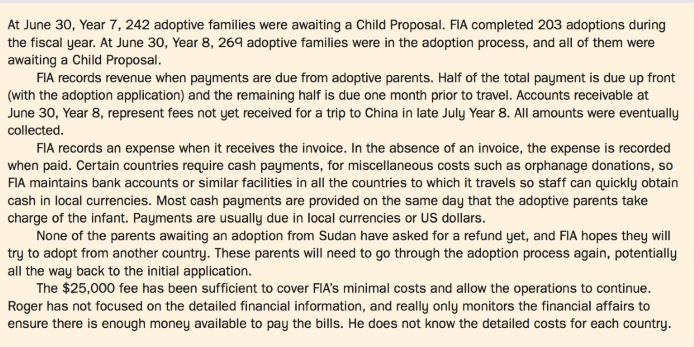
Exhibit X:
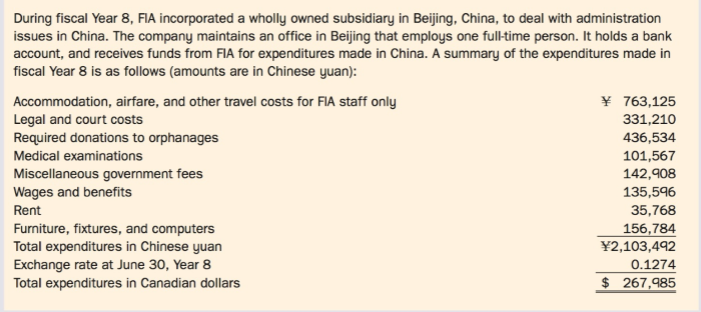
Transcribed Image Text:
The international adoption process can be daunting. FIA managers assist potential adoptive parents with every step of the process, from the initial application through to the post-adoption report. Managers also travel with parents to the countries where the adoptions take place, usually in groups of 10 families or fewer. Adoptive par- ents must cover their own travel expenses. Upon signing a contract, FIA charges a flat fee of $25,000, regardless of which country the parents adopt from. This fee pays all costs related to the adoption (averaging $20,000), and must also cover FIA's administra- tive and overhead costs. The following are the countries FIA supports through its international adoption assistance programs, and the number of adoptive families currently awaiting child proposals from each country: Country Pending Child Proposals China 68 India 58 Pakistan 47 Ethiopia 40 Sudan 38 Haiti 10 Philippines 269 Due to local hostilities and the deteriorating relationship between the Sudanese and Canadian governments, Sudan recently announced that they will not permit adoptions by Canadian residents after October 1, Year 8. To replace the number of adoptions FIA will lose as a result of the decision made by the Sudanese govern- ment, the company is considering expanding its list to include countries like Vietnam, Cambodia, and Afghani- stan. However, FIA does not have experience with these countries, or any formal criteria for determining whether a country should be added, so the managers are not sure how they should proceed. Several steps must be completed in order to adopt a child from a foreign country. While the steps vary slightly between countries, the adoption process is similar. 1. Adoption application. The adoptive parents complete an application in the format prescribed by the foreign authorities. A social worker performs a home assessment to ensure the applicants would be suitable par- ents for international adoption. The social worker prepares a report and forwards it to the foreign authori- ties. There is a long waiting period (anywhere from 6 to 24 months) before the adoptive parents receive a proposal from the foreign country. (continued) 2. Child proposal/acceptance. The foreign authorities propose a child for adoption. The adoptive parents must indicate within 48 hours whether they accept the proposed child. 3. Adoption finalization. About four weeks after the Child Proposal is accepted, the parents travel to the country to finalize the adoption. This includes paying legal fees, a mandatory orphanage donation, a medical examination fee, and other government fees. Typically this step takes between 10 and 12 days. 4. Post-adoption reports. Foreign countries require a progress report six months after adoption in order to ensure the child's well-being. The one-page report must be prepared by a social worker. Direct Adoption-Related Costs Although the costs can vary significantly between countries, the estimated average adoption-related costs are as follows: Adoption application (includes home assessment report) $ 4,100 Accommodation, airfare, and other travel costs for FIA staff only 3,500 Legal and court costs in foreign country 3,200 Mandatory donation to orphanage 4,000 Medical examination in foreign country 900 Other foreign government fees 4,300 $20,000 FOREIGN INFANTS ADOPTION INc. BALANCE SHEET As at June 30 (unaudited) Year 8 Year 7 Assets Current assets: Cash $2,097,474 $2,002,308 Accounts receivable 125,657 76,904 Prepaid insurance 35,500 26,575 2,258,631 2,105,787 127,768 $2,386,399 123,459 $2,229,246 Capital assets Liabilities Current liabilities: Accounts payable and accrued liabilities $ 391,062 $358,131 Wages payable 43,567 35,678 164,298 558,107 400,000 Other current liabilities 170,968 605,597 400,000 Shareholder's Equity Shareholder loan Common shares 100 100 Retained earnings 1,380,702 1,380,802 $2,386,399 1,271,039 1,271,139 $2,229,246 (continued) FOREIGN INFANTSS ADOPTION INC. INCOME STATEMENT For the years ended June 30 (unaudited) Year 8 Year 7 Revenue: Adoption fees $5,912,500 $5,467,500 20,542 5,933,042 18,674 5,486,174 Interest and other Expenses: Adoption application fee 1,027,915 965,830 Travel costs 765,745 726,706 Legal and court costs 675,420 660,398 Mandatory orphanage donations 827,600 796,500 Medical examinations 189,675 175,678 Miscellaneous foreign government fees 965,405 1,005,345 Administrative wages and benefits 485,672 421,876 Foreign country assistants' wages 250,224 345,698 China subsidiary operations (Exhibit X) 267,985 - Rent 145,985 154,325 Other expenses 182,320 5,783,946 170,986 5,423,342 Income before tax 149,096 62,832 39,433 $ 109,663 Income tax 16,789 Net income $ 46,043 At June 30, Year 7, 242 adoptive families were awaiting a Child Proposal. FIA completed 203 adoptions during the fiscal year. At June 30, Year 8, 269 adoptive families were in the adoption process, and all of them were awaiting a Child Proposal. FIA records revenue when payments are due from adoptive parents. Half of the total payment is due up front (with the adoption application) and the remaining half is due one month prior to travel. Accounts receivable at June 30, Year 8, represent fees not yet received for a trip to China in late July Year 8. All amounts were eventually collected. FIA records an expense when it receives the invoice. In the absence of an invoice, the expense is recorded when paid. Certain countries require cash payments, for miscellaneous costs such as orphanage donations, so FIA maintains bank accounts or similar facilities in all the countries to which it travels so staff can quickly obtain cash in local currencies. Most cash payments are provided on the same day that the adoptive parents take charge of the infant. Payments are usually due in local currencies or US dollars. None of the parents awaiting an adoption from Sudan have asked for a refund yet, and FIA hopes they will try to adopt from another country. These parents will need to go through the adoption process again, potentially all the way back to the initial application. The $25,000 fee has been sufficient to cover FIA's minimal costs and allow the operations to continue. Roger has not focused on the detailed financial information, and really only monitors the financial affairs to ensure there is enough money available to pay the bills. He does not know the detailed costs for each country. During fiscal Year 8, FIA incorporated a wholly owned subsidiary in Beijing, China, to deal with administration issues in China. The company maintains an office in Beijing that employs one full-time person. It holds a bank account, and receives funds from FIA for expenditures made in China. A summary of the expenditures made in fiscal Year 8 is as follows (amounts are in Chinese yuan): ¥ 763,125 Accommodation, airfare, and other travel costs for FIA staff only Legal and court costs 331,210 Required donations to orphanages 436,534 101,567 142,908 Medical examinations Miscellaneous government fees Wages and benefits 135,596 Rent 35,768 156,784 ¥2,103,492 Furniture, fixtures, and computers Total expenditures in Chinese yuan Exchange rate at June 30, Year 8 Total expenditures in Canadian dollars 0.1274 $ 267,985
> The statements of financial position of Pork Co. and Barrel Ltd. on December 31, Year 2, are shown next: Pork acquired 70% of the outstanding shares of Barrel on December 30, Year 2, for $329,000. Direct costs of the acquisition amounted to $12,000. Th
> The July 31, Year 3, balance sheets of two companies that are parties to a business combination are as follows: In addition to the property, plant, and equipment identified above, Red Corp. attributed a value of $100,000 to Sax's assembled workforce. T
> D Ltd. and H Corporation are both engaged in the manufacture of computers. On July 1, Year 5, they agree to a merger, whereby D will issue 300,000 shares with a current market value of $9 each for the net assets of H. Summarized balance sheets of the tw
> The balance sheet of Drake Enterprises as at December 31, Year 5, is as follows: Effective January 1, Year 6, Drake proposes to issue 82,500 common shares (currently trading at $20 per share) for all of the common shares of Hanson Industries. In determ
> How should a private company that has opted to follow ASPE report an investment in an associate?
> The shareholders of Prong Company and Hom Company agreed to a statutory amalgamation under which a share exchange took place. On September 1, Year 5, Prong Company issued 60,000 ordinary shares for all of the ordinary shares of Hom Company, after which H
> The statement of financial position of Bagley Incorporated as at July 31, Year 4, is as follows: On August 1, Year 4, the directors of Bagley considered a takeover offer from Davis Inc., whereby the corporation would sell all of its assets and liabilit
> Three companies, A, L, and M, whose December 31, Year 5, balance sheets appear below, have agreed to combine as at January 1, Year 6. Each of the companies has a very small proportion of an intensely competitive market dominated by four much larger compa
> G Company is considering the takeover of K Company whereby it will issue 7,400 common shares for all of the outstanding shares of K Company. K Company will become a wholly owned subsidiary of G Company. Prior to the acquisition, G Company had 13,000 shar
> The trial balances for Walla Corporation and Au Inc. at December 31, Year 4, just before the transaction described below, were as follows: On December 31, Year 4, Walla purchased all of the outstanding shares of Au Inc. by issuing 20,000 common shares
> The balance sheets of A Ltd. and B Ltd. on December 30, Year 6, are as follows: On December 31, Year 6, A issued 150 common shares for all 60 outstanding common shares of B. The fair value of each of B's common shares was $40 on this date. Required:
> Z Ltd. is a public company with factories and distribution centers located throughout Canada. It has 100,000 common shares outstanding. In past years, it has reported high earnings, but in Year 5, its earnings declined substantially in part due to a loss
> The financial statements for CAP Inc. and SAP Company for the year ended December 31, Year 5, follow: On December 31, Year 5, after the above figures were prepared, CAP issued $314,000 in debt and 12,400 new shares to the owners of SAP to purchase all
> Refer to Problem 11. All of the facts and data are the same except that in the proposed takeover, Myers Company will purchase all of the outstanding common shares of Norris Inc. Required: (a) Prepare the journal entries of Myers for each of the two pro
> Myers Company Ltd. was formed 10 years ago by the issuance of 34,000 common shares to three shareholders. Four years later, the company went public and issued an additional 30,000 common shares. The management of Myers is considering a takeover in which
> Which of the reporting methods described in this chapter would typically report the highest current ratio? Briefly explain.
> The following are summarized statements of financial position of three companies as at December 31, Year3: The fair values of the identifiable assets and liabilities of the three companies as at December 31, Year 3, were as follows: On January 2, Yea
> The balance sheets of Abdul Co. and Lana Co. on June 30, Year 2, just before the transaction described below, were as follows: On June 30, Year 2, Abdul Co. purchased all of Lana Co. assets and assumed all of Lana Co. liabilities for $58,000 in cash.
> All facts are the same as in Problem 8 except that COX applies ASPE. Follow the same instructions as those given in the Required: section of Problem 8. Data from Problem 8: COX Limited is a multinational telecommunication company owned by a Canadian b
> COX Limited is a multinational telecommunication company owned by a Canadian businesswoman. It has numerous long-term investments in a wide variety of equity instruments. Some investments have to be measured at fair value at each reporting date. In turn,
> Right Company purchased 25,000 common shares (25%) of ON Inc. on January 1, Year 11, for $250,000. Right uses the eq_uity method to report its investment in ON because it has significant influence in the operating and investing decisions made by ON. Righ
> On January 1, Year 2, Grow Corp. paid $200,000 to purchase 20,000 common shares of UP Inc., which represented an 8% interest in UP. On December 27, Year 2, UP declared and paid a dividend of $0.50 per common share. During Year 2, UP reported net income o
> Her Company purchased 22,000 common shares (20%) of Him Inc. on January 1, Year 4, for $374,000. Additional information on Him for the three years ending December 31, Year 6, is as follows: On December 31, Year 6, Her sold its investment in Him for $50
> Pender Corp. paid $285,000 for a 30% interest in Saltspring Limited on January 1, Year 6. During Year 6, Saltspring paid dividends of $110,000 and reported profit as follows: Pender's profit for Year 6 consisted of $990,000 in sales, expenses of $110,0
> On January 1, Year 5, Blake Corporation purchased 25% of the outstanding common shares of Stergis Limited for $1,850,000. The following relates to Stergis since the acquisition date: Required: (a) Assume that Blake is a public company and the number of
> Baskin purchased 20,000 common shares (20%) of Robbin on January 1, Year 5, for $275,000 and classified the investment as FVTPL. Robbin reported net income of $85,000 in Year 5 and $90,000 in Year 6, and paid dividends of $40,000 in each year. Robbin's s
> Briefly describe the trend in reporting of investments in equity securities over the past 12 years.
> Harmandeep Ltd. is a private company in the pharmaceutical industry. It has been preparing its financial statements in accordance with ASPE. Since it has plans to go public in the next three to five years, it is considering changing to IFRS for the curre
> The summarized trial balances of Phase Limited and Step Limited as of December 31, Year 5, are as follows (amounts in thousands): Phase had acquired the investment in Step in three stages: The January 1, Year 2, acquisition enabled Phase to elect 3 m
> On December 31, Year 6, Ultra Software Limited purchased 70,000 common shares (70%) of a major competitor, Personal Program Corporation (PPC), at $30 per share. Several shareholders who were unwilling to sell at that time owned the remaining common share
> On January 1, Year 8, Panet Company acquired 40,000 common shares of Saffer Corporation, a public company, for $500,000. This purchase represented 8% of the outstanding shares of Saffer. It was the intention of Panet to acquire more shares in the future
> On January 1, Year 4, a Canadian firm, Canuck Enterprises Ltd., borrowed US$208,000 from a bank in Seattle, Washington. Interest of 7.5% per annum is to be paid on December 31 of each year during the four-year term of the loan. Principal is to be repaid
> The Valleytown Senior's Residential Home (Valleytown) engages in palliative care, education, and fundraising programs. The costs of each program include the costs of personnel, premises, and other expenses that are directly related to providing the progr
> The William Robertson Society is a charitable organization funded by government grants and private donations. It prepares its annual financial statements using the restricted fund method in accordance with the CPA Canada Handbook, and uses both an operat
> All facts about this NFPO are identical to those described in Problem 11, except that the deferral method of recording contributions is used for accounting and for external financial reporting. Fund accounting is not used. The Year 6 transactions are als
> The Far North Centre (the Centre) is an anti-poverty organization funded by contributions from governments and the general public. For a number of years, it has been run by a small group of permanent employees with the help of part-timers and dedicated v
> All facts about this NFPO are identical to those described in Problem 9, except that the Centre wants to use the restricted fund method of accounting for contributions. The Centre will use two separate funds--operating and capital. The capital fund will
> In Year 1, XZY Co. expensed all development costs as incurred. How would the current ratio, debt-to-equity ratio and return on equity change if XZY Co. had capitalized the development costs?
> On December 31, Year 2, PAT Inc. of Halifax acquired 90% of the voting shares of Gioco Limited of Italy, for 690,000 euros (€). On the acquisition date, the fair values equaled the carrying amounts for all of Gioco's identifiable assets
> The Ford Historical Society is an NFPO funded by government grants and private donations. It uses both an operating fund and a capital fund. The capital fund accounts for moneys received and restricted for major capital asset acquisitions. The operating
> The Brown Training Centre is a charitable organization dedicated to providing computer training to unemployed people. Individuals must apply to the center and indicate why they would like to take the three-month training session. If their application is
> All facts about this NFPO are identical to those described in Problem 5, except for the following: 1. The Society will use the restricted fund method of accounting for contributions. 2. The Society will use three separate funds for reporting purposes--
> The Fara Littlebear Society is an NFPO funded by government grants and private donations. It was established in Year 5 by the friends of Fara Littlebear to encourage and promote the work of Native Canadian artists. Fara achieved international recognition
> Protect Purple Plants (PPP) uses the deferral method of accounting for contributions and has no separate fund for restricted contributions. On January 1, Year 6, PPP received its first restricted cash contribution-$120,000 for the purchase and maintenanc
> All facts about this NFPO are identical to those described in Problem 2, except that the association wants to use the deferral method of accounting for contributions. The center will continue to use the three separate funds. Required: Prepare a stateme
> The Perch Falls Minor Hockey Association was established in Perch Falls in January Year 5. Its mandate is to promote recreational hockey in the small community of Perch Falls. With the support of the provincial government, local business people, and many
> The OPI Care Centre is an NFPO funded by government grants and private donations. It prepares its annual financial statements using the deferral method of accounting for contributions, and it uses only the operations fund to account for all activities. T
> You, CPA, are employed at Beaulieu & Beauregard, Chartered Professional Accountants. On November 20, Year 3, Dominic Jones, a partner in your firm, sends you the following email: Our firm has been reappointed auditors of Floral Impressions Ltd. (FIL)
> Identify the financial statement ratios typically used to assess profitability, liquidity and solvency, respectively.
> Mega Communications Inc. (MCI) is a Canadian-owned public company operating throughout North America. Its core business is communications media, including newspapers, radio, television, and cable. The company's year-end is December 31. You, a CPA, have r
> RAD Communications Ltd. (RAD), a Canadian public company, recently purchased the shares of TOP Systems Inc. (TOP), a Canadian-controlled private corporation. Both companies are in the communications industry and own television, radio, and magazine and ne
> Vulcan Manufacturing Limited (VML) is a Canadian-based multinational plastics firm, with subsidiaries in several foreign countries and worldwide consolidated total assets of $500 million. VML's shares are listed on a Canadian stock exchange. VML is attra
> Long Life Enterprises was a well-€stablished Toronto-based company engaged in the importation and wholesale marketing of specialty grocery items originating in various countries of the western Pacific Rim. They had recently also entered the high-risk bus
> The Rider Corporation operates throughout Canada buying and selling widgets. In hopes of expanding into more profitable markets, the company recently decided to open a small subsidiary in California. On October 1, Year 2, Rider invested CDN$1,000,000 in
> You, CPA, have been working for Plener and Partners, Chartered Professional Accountants (P&P), a mid-size CPA firm, for three years. You have been assigned a new project for a long-term client of your firm, Oxford Developments Inc. (ODI). Information
> ZIM Inc. (ZIM) is a high-technology company that develops, designs, and manufactures telecommunications equipment. ZIM was founded in Year 5 by Dr. Alex Zimmer, the former assistant head of research and development at a major telephone company. He and th
> The United Football League (UFL), a North American professional football league, has been in work stoppage since July 1, Year 9, immediately after the six-week training camp ended. Faced with stalled negotiations, the players' union representing the leag
> Canada Cola Inc. (CCI) is a public company engaged in the manufacture and distribution of soft drinks across Canada. Its primary product is Canada Cola ("Fresh as a Canadian stream"), which is a top seller in Canada and generates large export sales. You
> For the items listed in Exhibit 1.1, for which items would the debt-to-equity ratio not change when a company switched from ASPE to IFRS? Exhibit 1.1: Accounting Item IFRS ASPE Very extensive for many items, especially financial instruments, post-e
> Interfast Corporation, a fastener manufacturer, has recently been expanding its sales through exports to foreign markets. Earlier this year, the company negotiated the sale of several thousand cases of fasteners to a wholesaler in the country of Loznia.
> Segment reporting can provide useful information for investors and competitors. Segment disclosures can result in competitive harm for the company making the disclosures. By analyzing segment information, potential competitors can identify and concentrat
> P Co. is looking for some additional financing in order to renovate one of the company's manufacturing plants. It is having difficulty getting new debt financing because its debt-to-equity ratio is higher than the 3:1limit stated in its bank covenant. It
> Mr. Landman has spent the last 10 years developing small commercial strip malls and has been very successful. He buys a residential property in a high-traffic area, rezones the property, and then sells it to a contractor who builds the plaza and sells it
> Enviro Facilities Inc. (EFl) is a large, diversified Canadian-controlled private company with several Canadian and U.S. subsidiaries, operating mainly in the waste management and disposal industry. EFl was incorporated more than 50 years ago, and has gro
> You, a CPA, have recently accepted a job at the accounting firm of Cat, Scan & Partners, as a manager, and have been assigned the audit of Vision Clothing Inc. (VCI). The partner in charge had been at VCI the previous week and had met with the contro
> Dry Quick (DQ) is a medium-sized, private manufacturing company located near Timmins, Ontario. DQ has a June 30 year-end. Your firm, Poivre & Sel (P&S), has recently been appointed as auditors for DQ. It is now August 2, Year 10. You, CPA, have b
> Traveller Bus Lines Inc. (TBL) is a wholly owned subsidiary of Canada Transport Enterprises Inc. (CTE), a publicly traded transportation and communications conglomerate. TBL is primarily in the business of operating buses over short- and long distance ro
> Identify some of the financial statement items for which ASPE is different from IFRS.
> For the past 10 years, Prince Company (Prince) has owned 75,000 or 75% of the common shares of Stiff Inc. (Stiff). Elizabeth Winer owns another 20% and the other 5% are widely held. Although Prince has the controlling interest, you would never know it du
> On December 31, Year 7, Pepper Company, a public company, agreed to a business combination with Salt Limited, an unrelated private company. Pepper issued 72 of its common shares for all (50) of the outstanding common shares of Salt 'This transaction incr
> It is Monday, September 13, Year 10. You, CPA, work at Fife & Richardson LLP, a CPA firm. Ken Simpson, one of the partners, approaches you mid-morning regarding Brennan & Sons Limited (BSL), a private company client for which you performed the Au
> Stephanie Baker is an audit senior with the public accounting firm of Wilson & Lang. It is February Year 9, and the audit of Canadian Development Limited (CDL) for the year ended December 31, Year 8, is proceeding. Stephanie has identified several transa
> On January 1, Year 4, Plum purchased 100% of the common shares of Slum. On December 31, Year 5, Slum purchased a machine for $168,000 from an external supplier. The machine had an estimated useful life of six years with no residual value. On December 31,
> In early September Year 1, your firm's audit client, D Ltd. (D) acquired in separate transactions an 80% interest in N Ltd. (N) and a 40% interest in K Ltd. (K). All three companies are federally incorporated Canadian companies and have August 31 year-en
> Enron Corporation's 2000 financial statements disclosed the following transaction with LIM2, a nonconsolidated special purpose entity (SPE) that was formed by Enron: In June 2000, LIM2 purchased dark fibre optic cable from Enron for a purchase price of
> Digital Future Technologies (DFT) is a public technology company. It has a September 30 year-end, and last year it adopted IFRS. Kin Lo is a partner with Hi & Lo, the accounting firm that was newly appointed as DFT's auditor in July for the year endi
> Wedding Planners Limited (WP), owned by Anne and Francois Tremblay, provides wedding planning and related services. WP owns a building (the Pavilion) that has been custom-made for hosting weddings. Usually, WP plans a wedding from start to finish and hos
> You, the CPA, an audit senior at Grey & Co., Chartered Professional Accountants, are in charge of this year's audit of Plex-Fame Corporation (PFC). PFC is a rapidly expanding, diversified, and publicly owned entertainment company with operations througho
> Briefly explain why a Canadian private company may decide to follow IFRS even though it could follow ASPE.
> Distinguish between unrestricted and restricted contributions of a charitable organization.
> Good Quality Auto Parts Limited (GQ) is a medium-sized, privately owned producer of auto parts, which are sold to car manufacturers, repair shops, and retail outlets. In March Year 10, the union negotiated a new three-year contract with the company for t
> You, the controller, recently had the following discussion with the president: President: I just don't understand why we can't recognize the revenue from the intercompany sale of inventory on the consolidated financial statements. The subsidiary company
> Gerry's Fabrics Ltd. (GFL), a private company, manufactures a variety of clothing for women and children and sells it to retailers across Canada. Until recently, the company has operated from the same plant since its incorporation under federal legislati
> Beaver Ridge Oilers' Players Association and Mr. Slim, the CEO of the Beaver Ridge Oilers Hockey Club (Club), ask for your help in resolving a salary dispute. Mr. Slim presents the following income statement to the player representatives: Mr. Slim argu
> Total Protection Limited (TPL) was incorporated on January 1, Year 1, by five homebuilders in central Canada to provide warranty protection for new-home buyers. Each shareholder owns a 20% interest in TPL. While most homebuilders provide one-year warrant
> It is now mid-September Year 3. Growth Investments Limited (GIL) has been owned by Sam and Ida Growth since its incorporation under the Canada Business Corporations Act many years ago. The owners, both 55 years of age, have decided to effect a corporate
> BIO Company is a private company. It employs 30 engineers and scientists who are involved with research and development of various biomedical devices. All of the engineers and scientists are highly regarded and highly paid in the field of biomedical rese
> It is September 15, Year 8. The partner has called you, CPA, into his office to discuss a special engagement related to a purchase agreement. John Toffler, a successful entrepreneur with several different businesses in the automotive sector, is finalizin
> Lauder Adventures Limited (LAL) was incorporated over 40 years ago as an amusement park and golf course. Over time, a nearby city has grown to the point where it borders on LAL's properties. In recent years LAL's owners, who are all members of one family
> When Valero Energy Corp. acquired Ultramar Diamond Shamrock Corp. (UDS) for US$6 billion, it created the second-largest refiner of petroleum products in North America, with over 23,000 employees in the United States and Canada, total assets of $10 billio
> Briefly explain why the Canadian AcSB decided to create a separate section of the CPA Canada Handbook for private enterprises.
> Factory Optical Distributors (FOD) is a publicly held manufacturer and distributor of high-quality eyeglass lenses located in Burnaby, British Columbia. For the past 10 years, the company has sold its lenses on a wholesale basis to optical shops across C
> On December 31, Year 7, Maple Company issued preferred shares with a fair value of $1,200,000 to acquire 24,000 (60%) of the common shares of Leafs Limited. The Leafs shares were trading in the market at around $40 per share just days prior to and just a
> Planet Publishing Limited (Planet) is a medium-sized, privately owned Canadian company that holds exclusive Canadian distribution rights for the publications of Typset Daily Corporation (TDC). Space Communications Ltd. (Space), an unrelated privately own
> How are translation exchange gains and losses reflected in financial statements if the foreign operation's functional currency is the Canadian dollar? Would the treatment be different if the foreign operation's functional currency were not the Canadian d
> What translation method should be used for a subsidiary that operates in a highly inflationary environment? Why?
> What difference does it make whether the foreign operation's functional currency is the same or different than the parent's presentation currency? What method of translation should be used for each?
> What should happen if a foreign subsidiary's financial statements have been prepared using accounting principles different from those used in Canada?
> Define a foreign operation as per IAS 21.
> How are gains and losses on financial instruments used to hedge the net investment in a foreign operation reported in the consolidated financial statements when the PCT method is used to translate the foreign operation?

